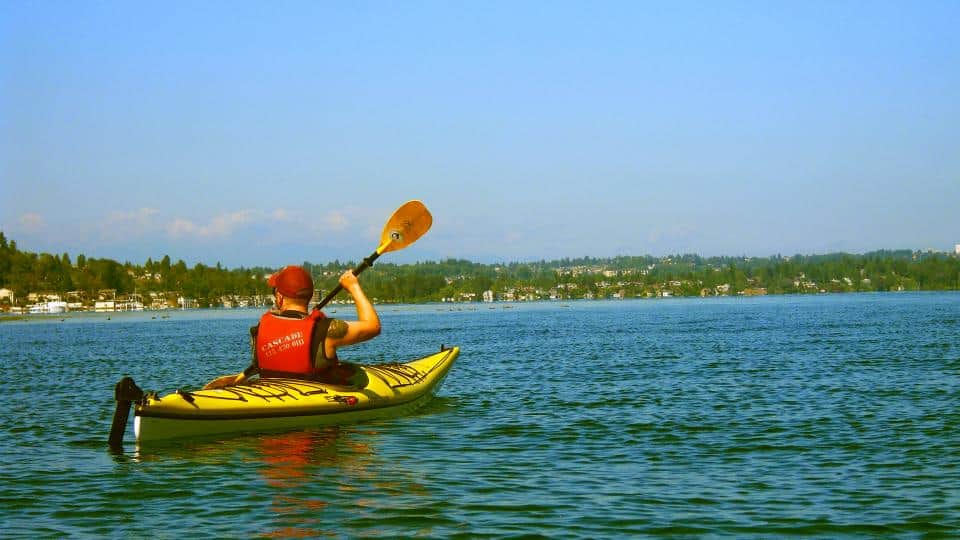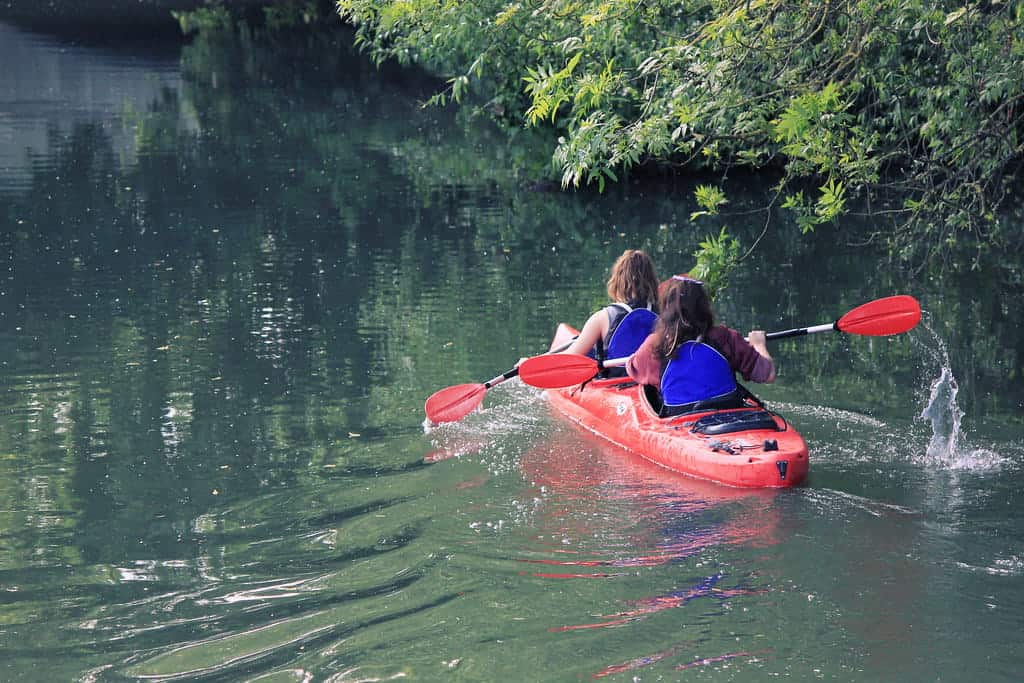Kayaking is an excellent experience for those who love water excursions. Yet, your enjoyment will decrease somewhat once the water leaks into your boat.
Do you get wet kayaking easily? How to stay dry during your trip? These questions remain a huge headache for kayakers, but things are different today.
This article will explain some cases where you become soaked while kayaking. You can also learn some tips to avoid it. Let’s read on for more details!

Do You Get Wet Kayaking?
You can get wet when kayaking because even if you are sitting securely on your seat, water can leak into your boat.
Most kayakers stay dry while paddling. Yet, you should nonetheless get familiar with frequent water exposure sources.
Splashes
You can’t kayak without paddling, and you need the paddles to move forward to your destination.
Often, you will perform at least hundreds of paddling strokes in a long excursion.
At least a few strokes will make contact with the water incorrectly, bringing water blasting back in your path.
Although some drops of water may not matter, they will build up after a lengthy paddling journey.
These splashes can’t soak you. But, if you want to be completely dry throughout your trip, they might be pretty annoying.
Wave spray
Another common way that kayakers get a little wet is from wave spray. This problem doesn’t often occur on calm water.
However, your fellow boaters may unintentionally enlarge the waves, making you get wet even when kayaking on a tranquil lake.
For instance, the waves produced by speed boats or jet skis can be big enough to cause splashes to rise the kayak’s hull, especially if other boaters are going fast.
In high traffic zones, a normally tranquil lake may become considerably rough, raising your chance of getting soaked.
Be ready for the backsplash if you want to paddle in a wavy zone, like the ocean or a big river.
Unlike smoother settings, accidental splashes are likelier to aim at you in those water terrains.
Tipping
The last and most direct way to get soaked while kayaking is by flipping the kayak over and falling into the water.
When this accident occurs, you will be entirely wet for at least the next few hours. All your stuff in the boat will become soaked too.
The biggest problem you want to avoid during a paddling expedition is swamping your kayak.
Luckily, it’s quite challenging to flip over a kayak, particularly in flat waters.
Even inexperienced paddlers who have never used a paddle typically stay away from tipping over the boat during their first practice.
Recreational kayaks have flatter hulls and are more difficult to tip over, perfect for stability on calm waters.
This kind of hull construction makes it easier for kayakers to distribute their weight evenly throughout the boat, lowering the likelihood of capsizing.
How To Kayak Without Getting Wet?
Every kayak wants to stay dry during their trips. Fortunately, the following tips will help you with this.
Install drip guard placement
Many kayakers, especially beginners, don’t appreciate the importance of drip guards. They serve as a barrier between your hands and the paddle’s shaft.
Hence, they can prevent water from leaking onto your hands and entering your kayak’s cockpit.
However, since most kayaks have rubber drip guards, they occasionally stretch and enlarge with use.
Another frequent occurrence when hiring a kayak is receiving a paddle without drip protectors.
However, your paddle must have adequately two drip guards if you want to kayak without getting soaked.
To get your drip guards closest to the blades, slide them out and away from the paddle shaft’s center.
When you paddle, the blade that was recently underwater can rise, and any water droplets on it start to drop toward the shaft.

Use a spray skirt
Spray skirts come in different styles, but they all typically have a neoprene seal that fits around your waistline and a rope that fastens around the cockpit rim of your boat. Some spray skirts feature straps that cross over your shoulders.
The easiest method for using these skirts is to put them on before getting into your boat and tie the bottom edge around the kayak cockpit rim.
On the other hand, you can put on a skirt while you are in the water. You might need to discard your PFD or other kayaking gear to fit the skirt beneath.
However, please remember that spray skirts will only protect your lower body. Your hands, head, and upper body will still suffer from the rain and wavy waters.
Kayaking in cold or rainy weather can significantly affect your lower body’s comfort. In this case, a spray skirt can ensure that your lower body stays dry and keeps you warm by retaining more heat inside the kayak cockpit.
Wear a drysuit
You can also use a drysuit when paddling if you know there will be rain and splashing water.
Even in the toughest weather, the best drysuits will keep you warm and dry.
Drysuits are brilliant because you can wear more regular clothing items underneath them.
They seal around your wrists, ankles, and neck, preventing water from leaking.
Feel free to mix with your clothes if you want to get warmer. Choose thinner items to wear with your drysuit if the weather is hot. The flexibility makes this suit an ideal year-round solution for kayakers.
Drysuits’ disadvantage is that they don’t breathe effectively in hotter climates.
Therefore, you might better wear a regular rain jacket with a spray skirt. This combination is the best if you kayak in the rain, but the climate is hot.
Check for the weather.
You will definitely get wet because of the rain. Hence, before kayaking, ensure there won’t be any chance of precipitation.
All kayakers, regardless of skill level, should check the weather frequently. It’s critical for those who want to remain as dry as possible.
Of course, there are other weather elements you should consider while checking the forecast in addition to the precipitation.
So, pay attention to wind gusts, wind speed, and wind direction too. You may capsize in wavy and windy conditions.
Choose the location and time.
Many inexperienced kayakers overlook the timing and location of their paddles.
For instance, if it’s a busy weekend, you will encounter more motorized boats when heading out on the water in the middle of the day.
Increased boat traffic sometimes leads to a higher chance of running with reckless boaters.
Many kayakers who followed all other safety procedures ended up taking an accidental swim because of the risky behaviors of other boaters.
So, you should be careful when choosing the date and spot of your kayaking excursions if you don’t want to run into other boats or kayaks that get you wet.
If possible, avoid the peak times of the day by waking up early. Moreover, the morning is the calmest time of day for many lakes and coastal waterways.
Learn the dock-start technique
To climb into your kayak, you typically must step into the water. However, this technique is not the best one. Instead, learn how to do it from a dock properly.
Nowadays, some really nice EZ launch docks are available specifically to provide accessibility for those with impairments.
You can use those docks for a dry start if you don’t want to go kayaking with wet feet.
Conclusion
You can get wet while kayaking. However, getting wet while kayaking is common, but you can avoid it with some tips we have shared.
Remember to bring the necessary gear and check the weather for the best experience. Thank you for taking the time to read this!